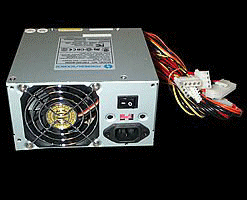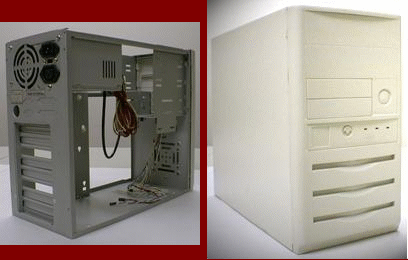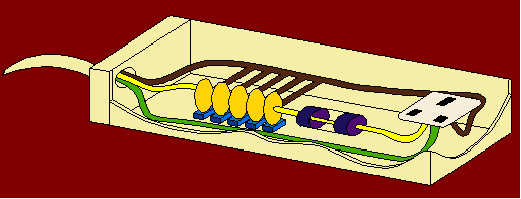Case and Power Supply
|
|
The case or system box is usually the large beige box in front of you, but in toady's market, cases are becoming multicoloured so yours may vary from the picture (right). The function of the case is to house all the computers parts, provide ventilation for the heat they produce and protect against radio frequency interference.
|
This is because computers produce lots of radio frequency �noise� in the FM radio band. So all cases are certified by the Federal Communication Commission (FCC) as non-interfering with assigned broadcast frequencies.
|
The power supply is mounted inside the case and serves two purposes. The first being to supply electricity o all the parts in the computer at the proper voltage levels. The power supply operates on 115 volts alternating current (VAC) from the wall socket. On older computer systems (AT standard), the 115 VAC was wired to a switch on the front of the system box, just like a lamp, but in new cases (ATX standard) the 115 VAC never leaves the power supply.
|
|
The power in new computers is never really off, it is always supplying a small amount of current to the motherboard, which can tell the power supply when to �wake-up� fully such as when the phone connected to the modem rings or when you press the low voltage power switch (really a logic switch) on the front of the case.
|
|
The second purpose of the power supply is to cool the parts in the case by use of a fan contained in the power supply. The power supplies on new (ATX) cases draw cold air from the outside the case and blow it into the case.
|
|
It is ideal that the extension lead that supplies all the power to your computer and its peripherals is surge protected. In an ideal world, electrical currents would stay within close limits of its voltage and frequency. But in today's electronic environment there are many factors that could cause power sags, power surges, or general electric noise, these problems could cause your computer or peripherals to malfunction or even crash and be destroyed. So to combat these power disruptions surge protector extension leads have been developed. Power surge protectors provide line conditioning which tries to compensate for irregularities in current. The first line of defence is the shunt mode. This mode uses a metal oxide varistor (MOV). MOV consists of metal oxide material which transmits electricity separated by semiconductors that don't carry current unless the supply voltage reaches a certain level. If this level is reached usually by a power surge the MOVs resistance is overcome thus opening the pathway that diverts the surge to the neutral wire.
|
If the power surge is too large the next defence is a thermal fuse which blocks the rush of current. The fuse is a resistor that will get hot and melt if too much current is passed through it. This fuse can only work once, and would need to be replaced if used.
|
This whole process is shown below.
|
|












